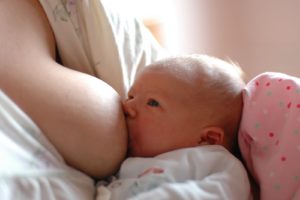 Researchers have known for a while that human breast milk contains hundreds of species of bacteria that a baby ingests while feeding. This is good! The bacteria is seeding the baby's gut microbiome (microbial community). A recent study of breast milk from different continents found that breast milk from healthy mothers also contains species of fungi - which is the breast milk mycobiome. What was noteworthy was that some types of fungi in breast milk were found among breast milk samples from all locations (a fungi "core group"), while other types of fungi varied among breast milk from the different locations and even how the baby was delivered (vaginal or C-section birth).
Researchers have known for a while that human breast milk contains hundreds of species of bacteria that a baby ingests while feeding. This is good! The bacteria is seeding the baby's gut microbiome (microbial community). A recent study of breast milk from different continents found that breast milk from healthy mothers also contains species of fungi - which is the breast milk mycobiome. What was noteworthy was that some types of fungi in breast milk were found among breast milk samples from all locations (a fungi "core group"), while other types of fungi varied among breast milk from the different locations and even how the baby was delivered (vaginal or C-section birth).
After analyzing the 80 samples of breast milk (20 from each country: Spain, Finland, South Africa, China) it was found that some fungi were the same in breast milk from the different locations: Malassezia, Davidiella, Sistotrema, and Penicillium, while others were different. Fungi from the genus Cryptococcus were higher in breast milk from women who delivered vaginally (as compared to those who had a C-section). [Note: Genus ranks above species, but below family, and the written name is capitalized.]
This study confirms the importance of breast milk as a source of microbes (along with many nutrients and protective compounds) to the infant and infant gut. From Science Daily:
Breast milk microbiome contains yeast and fungi: Do these benefit the infant?
Investigators have now shown that the breast milk microbiome contains fungi. Multiple previous studies had found bacteria in breast milk. Certain fungi and bacteria have been shown to be important probiotics for infant health. The research is published in Applied and Environmental Microbiology, a journal of the American Society for Microbiology.
"Our research demonstrates the presence of yeasts and other fungi in breast milk in healthy mothers, supporting the hypothesis that breast milk is an important source of microorganisms to the growing infant," said principal investigator Maria Carmen Collado, PhD, Senior Researcher, the Institute of Agrochemistry and Food Technology, National Research Council, Valencia, Spain.
Having established in earlier research the presence of yeasts and other fungi in breast milk from mothers in Spain, the investigators sampled breast milk from mothers in other geographic locations, including Finland, China, and South Africa, to find out whether this finding held up in locations with different weather, diets, and lifestyles from those in southern Europe.
"Our data confirm the presence of fungi in breast milk across continents and support the potential role of breast milk on the initial seeding of fungal species to the infant gut," the investigators wrote. "This supports the existence of a 'breast milk mycobiota' under healthy conditions."
The genera Malassezia and Davidiella were most prevalent across the different countries. Those two, as well as Sistotrema and Penicillium, were present in breast milk from each country.
More than 70 percent of Spanish and South African samples had detectable levels of fungal DNA, while only 45 percent of Chinese samples and only 35 percent of Finnish samples did so. Despite the similarities of the mycobiomes across the four countries, "Our findings reinforce the potential influence of environmental factors, in particular geographic location, on the species of yeast and fungi that make up the breast milk mycobiome," said Dr. Collado.
The investigators also compared the breast milk mycobiome in mothers who had delivered vaginally with that from mothers who had delivered via cesarean section. Specific fungi, such as those of the genus Cryptococcus, were more prevalent among samples from mothers delivering vaginally, but mode of delivery made no difference in fungal diversity or richness.
The investigators did not identify the sources of the breast milk mycobiome, but Malassezia are found in around the sebaceous glands, glands that secrete oils to lubricate hair and skin. Davidiella have been found in the vagina. And Saccharomyces, also present in breast milk, are among the most abundant fungi in the gut.
 Breastfeeding baby. Credit: Anton Nosik, Wikimedia commons.
Breastfeeding baby. Credit: Anton Nosik, Wikimedia commons.

But I do like to add it for coffee creamer and/or for drinking, granola, etc. All the ingredients are to taste, really. I find simply blending the cashews alone too to be delicious! I hope this helps and you enjoy the recipe